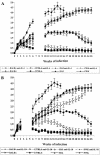Inbred strains derived from feral mice reveal new pathogenic mechanisms of experimental leishmaniasis due to Leishmania major
- PMID: 15271920
- PMCID: PMC470675
- DOI: 10.1128/IAI.72.8.4603-4611.2004
Inbred strains derived from feral mice reveal new pathogenic mechanisms of experimental leishmaniasis due to Leishmania major
Abstract
Two inbred mouse strains, derived from feral founders, are susceptible to experimental leishmaniasis due to Leishmania major and support a disease of a severity intermediate between those observed in strains C57BL/6 and BALB/c. Mice of the MAI strain develop a severe, nonhealing, but nonfatal disease with no resistance to a secondary parasite challenge. The immunological responses showed a TH2 dominance characterized by an early peak of interleukin-4 (IL-4) and IL-13. However, neutralization of IL-4, which leads to a resistance phenotype in BALB/c mice, has no effect on disease progression in MAI mice. Mice of strain PWK develop a protracted but self-healing disease, characterized by a mixed TH1-plus-TH2 pattern of immune responses in which IL-10 plays an aggravating role, and acquire resistance to a secondary challenge. These features are close to those observed in human cutaneous leishmaniasis due to L. major and make PWK mice a suitable model for the human disease.
Figures




References
-
- Barral, A., E. A. Peterson, D. L. Sacks, and F. A. Neva. 1983. Late metastatic leishmaniasis in the mouse. A model for mucocutaneous disease. Am. J. Trop. Med. Hyg. 32:277-285. - PubMed
-
- Beebe, A. M., S. Mauze, N. J. Schork, and R. L. Coffman. 1997. Serial backcross mapping of multiple loci associated with resistance to Leishmania major in mice. Immunity 6:551-557. - PubMed
-
- Belkaid, Y., K. F. Hoffmann, S. Mendez, S. Kamhawi, M. C. Udey, T. A. Wynn, and D. L. Sacks. 2001. The role of interleukin (IL)-10 in the persistence of Leishmania major in the skin after healing and the therapeutic potential of anti-IL-10 receptor antibody for sterile cure. J. Exp. Med. 194:1497-1506. - PMC - PubMed
-
- Blackwell, J. M., G. F. Black, C. S. Peacock, E. N. Miller, D. Sibthorpe, D. Gnananandha, J. J. Shaw, F. Silveira, Z. Lins-Lainson, F. Ramos, A. Collins, and M. A. Shaw. 1997. Immunogenetics of leishmanial and mycobacterial infections: the Belem Family Study. Philos. Trans. R. Soc. Lond. B 352:1331-1345. - PMC - PubMed
Publication types
MeSH terms
Substances
LinkOut - more resources
Full Text Sources
Molecular Biology Databases

